| Expe 1993 | Expe 1995 | Expe 1997 | Expe 2000 | Expe 2001 | Expe 2002 |
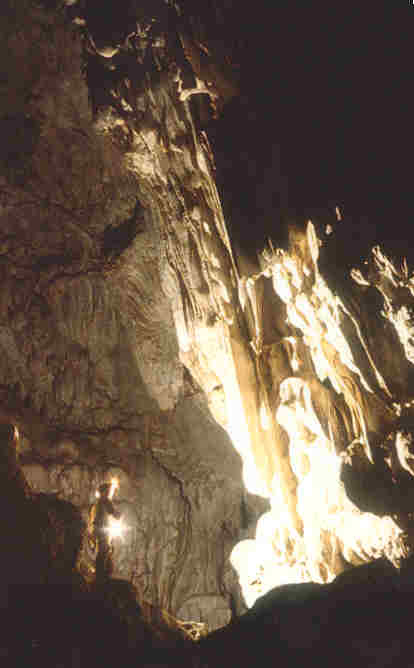 |
First expedition: 1993
On the first Belgian caving expedition in Vietnam, in 1993, the aim was to find the underground part of the Nam La river, which disappears in a sinkhole close to Son La town. The resurgence was found in Hang Doi cave. The team surveyed 4 areas in the surroundings of Son La. These areas were very successful: 22 caves, with a total length of more than 10 km were discovered. Among them the long horizontal caves of Hang Doi 1 (1435m), Hang Ran (1717m), Nam Khum (1323m), Thi Doi (1551 m) and the deepest vertical, Queen’s Cave (- 151m). Back to Top |
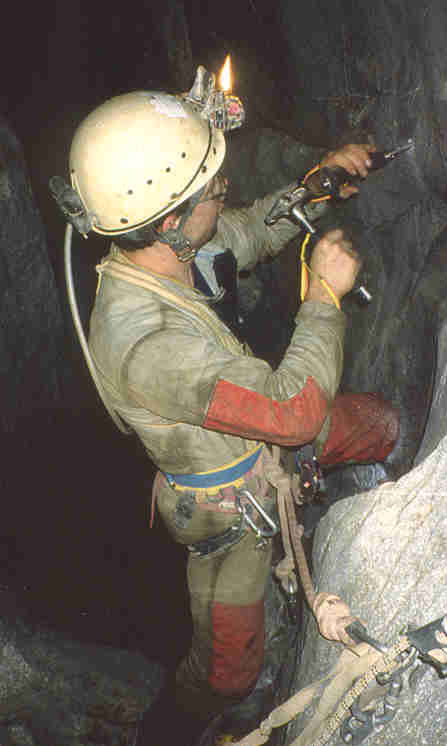 |
Second expedition: 1995
The remaining potential for further exploration of this area was considered to be enough for organising a second caving expedition. The 1995 expedition was planned in the same region. The same areas were explored more thoroughly and four more areas were mapped out. On this second expedition, 37 new caves were surveyed, with a total development of over 7 km, most of them being rather small caves. Tham Han (623m) is a beautiful underground river, Tham Hoa (582m), Ban Lay (548m) and Bo Hom (645m) were the longest new caves found. Some caves of the previous expedition were continued. Hang Ran was prolonged to a length of 1880m and in Queen’s Cave some new pitches were descended up to a sump at -168m. Back to Top |
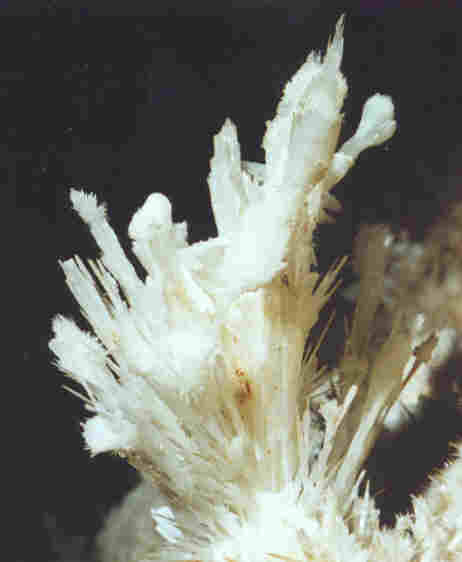 |
Third expedition: 1997
The third expedition went further to the north. Ten new areas were defined, from Thuan Chau to Tuan Giao and Tua Chua and from Quynh Nhai along the Da River. As a large area had to be prospected, all exploration was done by four-wheel drive. The exploration along the Da River was done by boat. On this expedition 38 caves were surveyed, with a total length over 17 km. Mo Cong 1 (1029m), Chieng Ban 4 (1382m), Ban De 2 (829m), Sinh Su 1 (947m), Sinh Su 3 (975m), Pa Nha 1 (1335m), Ta Chinh (923m) and Ba Phong 1 (900m) were the largest caves. Ta Chinh became the deepest cave of nort-west Vietnam, with a depth of -184m and is still going. Many charming caves were found during this expedition: the Chieng Ban caves form a system of a marvellous underground river, Kha Pua has an impressive entrance, Sinh Su 1 and its 50m entrance pitch, Sinh Su 3 has beautiful flower-like formations and could be turned into a show cave. Large, almost perfectly rounded cave pearls were found, ‘dragon eggs’, over 10 cm in diameter laying on white, nest-like flowstone in the middle of a dark coloured fossil cave. One pearl was taken out of the cave for measuring and photographing, and brought back where it belongs (see picture on the home page). Back to Top |
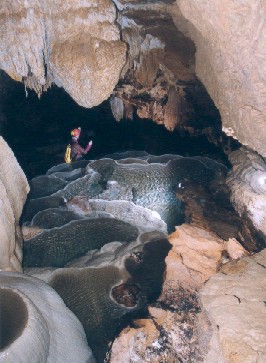 |
Fourth expedition: 2000
The fourth expedition started in Son La, where we discovered two new caves that gave more information on the underground part of the Nam La river. A dye test gave the evidence that the underground river of Tham Han exsurges in the Suoi Moi river. In Tua Chua, the exploration of Ta Chinh continued: we reached -300m, but had to abandon the cave after a period of heavy rain : we saw the entrance sump of the cave closing behind us! The new areas that were defined around Tam Duong, in the very north of Vietnam, were all very successful: Si Leng Chai (1162m, -286m) is a very sporting cave with a great underground river and the most beautiful basins we ever admired. The very vertical cave of Hang Doi Nuoc reached -286m en keeps going. In the Dong Pao area, the Nam Hon river disappears four times undground for and was mapped for over 2.5 km. On this expedition 21 caves were surveyed, with a total length over 11 km. This expedition was more sporting than the previous ones because of the weather conditions and the depth of the caves (three caves reached a depth close to -300 m.). Back to Top |
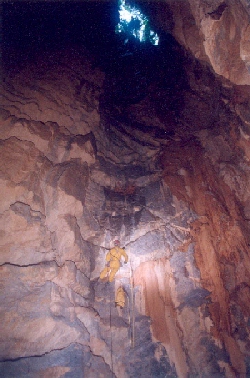 |
Fifth expedition: 2001
The fifth expedition, from December 25, 2000 to January 13th, 2001 went directly to Lai Chau province. In Tua Chua, the exploration of some caves that started in 1997 was continued, others were revisited for photography. In Ta Chinh, a sump was reached at -402m, after over 2km of magnificent passageway. Some more interesting phenomena - entrance pitches of over 100m - were found in the near and were only partly explored. In Tam Duong area, another very promising cave, Cong Nuoc, was measured
up to a depth of -410m and is still going. In it, a small pitch of over
200m was descended!
On this expedition 26 new caves were surveyed, with a total length of about 10 km. Cong Nuoc an Ta Chinh are now the second an third deepest caves of Vietnam. Since we explored further away from the main roads, this expedition again involved longer walks, sometimes through beautiful and dense jungle. Back to Top |
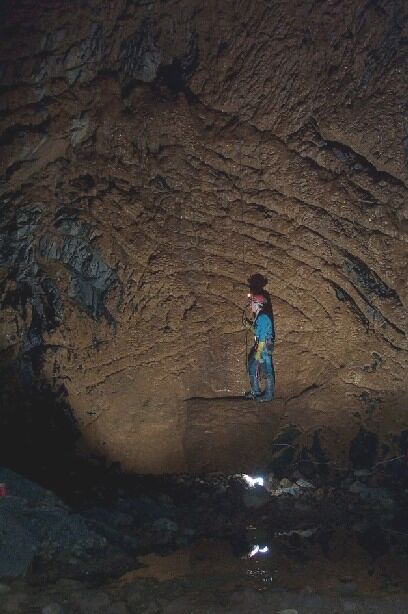 |
Sixth
expedition: 2002 *NEW DEPTH RECORD* (click
here for survey of the deepest cave in Vietnam) From December 18th 2001 till January 10th 2002, Tua Chua and Tam Duong regions were visited again during the 6th expedition. Towards the end of our stay, some initial prospecting was also done on the Sin Ho plateau. Twenty caves were surveyed with a total development of 6.5km during this expedition. The Cang Ti caves were further explored and ended a bit too soon; Cang Ti 1 (159m, -137m) has an entrance pitch of 119m and ends on a choke. The sinkhole of an important river, Cang Ti 2 (376m, -254) ended on a small sump. The presence of living and croaking frogs throughout the cave - including on the walls of the 85m “Pitch of the Suicidal Frogs” - was quite remarkable. More to the north-west of the Tua Chua Plateau, around the village of Lau Cau Phin, several beautiful caves were found, with rather small dimensions (Lau Cau Phin 1, 208m, -99). In the northern part, close to the city of Sin Chai, a sink was explored (342m, -193) till the top of a 20m pitch and is still going. The big news came from the Tam Duong area, where on Christmas Eve, Cong Nuoc was pushed down to a master cave at -600m which was however soon choked in both directions. It became the deepest cave of Vietnam and Southeast Asia! Since it was forbidden to walk through the mountains at night, the team was forced to spend the nights inside. Interesting geological phenomena, such as basalt intrusions, could be observed. Also in Chieu Sai Pin area, Yen Chau Do cave was descended till a too narrow crack at -301m. The longest cave explored during this expedition was the resurgence of Xa Nam Loong (1208m, +81). Back to Top |
Use of the collected data
During these joint expeditions several data were collected which
were of use for the study « Karst geology investigation of the Northwest
region » by Dr. Do Tuyet (Editor-in-chief) and for the preparation
of a joint development project « Rural development in the mountain
karst area of NW Vietnam by sustainable water and land management and social
learning: its conditions and facilitation » which will be implemented
in the future. The data which are summarised in this report should contribute
to gain a better knowledge of the underground water flows in the areas
that have been investigated. The surveys give detailed information on location
and development of cave systems, which could be used to indicate good positions
for drilling water wells. They should allow to better assess the touristic
potential of the areas as well as the hydroelectric potential and the risk
of pollution and natural hazards. The new development project, which is
starting, can build further upon the data which are collected here.
Back to Top